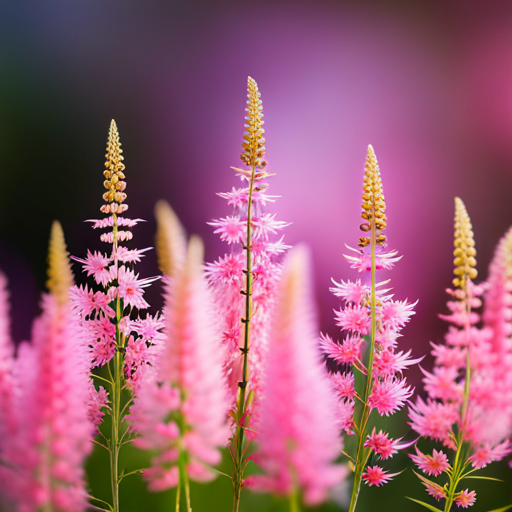
This resilient and elegant perennial is a popular choice for many gardeners wanting to add texture and vibrancy to their shady retreats. If you’re looking to start an astilbe collection or breathe new life into your existing patch. Understanding the nuances of astilbe care will ensure these beauties thrive. In this post, we’ll walk through everything about Astilbe plant care. From selecting the right spot in your garden to pampering your astilbes throughout the year.
Light Requirements for Astilbe Plants
Astilbes are renowned for their love of shade, and it’s not just any kind of shade – the dappled kind is their favorite. This means a spot in the garden where they’ll receive morning sunlight that filters through the trees, followed by the gentle shade of the afternoon. However, too much shade can lead to leggy growth, and not enough can result in burnt leaves. It’s all about finding that delicate balance.
Not all shades are created equal. Understanding the types of shade – full, partial, and dappled – is crucial. Full shade means complete sunlight blockage, partial shade receives a few hours of direct sun, while dappled shade likely casts light and shadow throughout the day.
Soil Preparation for Astilbe
Astilbes are not too demanding when it comes to soil, but they absolutely require it to be moist, well-draining and rich in organic matter. The soil’s consistency is of particular importance during their growing season, as it will keep them from drying out or, alternatively, becoming waterlogged.
The pH level of your soil influences the plant’s ability to uptake nutrients. Aim for a slightly acidic or neutral pH in the range of 5.5 to 7.0. Soil test kits are available at garden centers or through online suppliers.
If your soil doesn’t meet astilbe’s preferences, you can modify it. For heavy clay soil that drains poorly, incorporate organic matter, like compost, to improve drainage. To increase acidity, add peat moss or elemental sulfur. For alkaline soil, the addition of powdered sulfur can help lower the pH.
Planting Astilbe in Your Garden
When and how you plant your astilbe can significantly impact its health. This is an important step that provides the foundation for the plant to establish itself and grow.
The ideal time to plant astilbes is in early spring or fall, giving them time to settle in before the hot summer sun starts to beat down. However, you can plant container-grown astilbes any time during the growing season.
When planting, make sure to cover the roots with soil and pack it gently to remove air pockets. The crown, which is where the stems and roots meet, should sit just at the surface of the soil. This is a vital step as planting too deep can lead to rot.
Water and Fertilizer for Growing Astilbe
Proper watering and feeding are crucial for astilbes, especially right after planting. These practices ensure that your astilbes grow vigorously and produce those ornate flower plumes.
Astilbes are thirsty plants, especially during the summer, so maintaining even moisture is key. A regular watering schedule, supplemented by a layer of mulch, can help conserve moisture and keep the soil from drying out.
Fertilizing Facts
Astilbes are light feeders but can benefit from a balanced fertilizer in the spring, just as new shoots emerge. Granular slow-release fertilizers work well. Follow the instructions on the packaging, as over-fertilizing can lead to excessive leaf growth with few flowers.
Dividing Your Astilbe – When, Why, and How
Over time, astilbes can outgrow their space and become less vigorous in their growth and bloom. Dividing your astilbes rejuvenates them and gives you the opportunity to multiply your plants.
When to Divide
The best time to divide astilbes is in early spring as soon as you see new growth, or in the fall before the ground freezes. Dividing in the spring allows the plants to establish before the stress of summer, and fall divisions have a head start for root development in the spring.
The Division Process
To divide an astilbe, simply dig up the entire plant, making sure to get a good portion of the root ball. Then, divide it into sections, ensuring that each new plant has both roots and stems. Replant as you would a new astilbe.
Winterizing Your Astilbe Garden
In regions with harsh winters, a little preparation can help your astilbes survive and thrive once spring returns.
After the first frost, add a layer of mulch around astilbes to protect them from temperature fluctuations and drying wind.
In late fall or early winter, cut back the foliage to about an inch above the ground, removing any dead or dying material. Do this after a couple of good freezes, as this can help prevent attracting pests.
Happy Gardening!
Your astilbes are a valuable addition to your garden or landscape, and by providing the right light, soil conditions, and attentive care, they will flourish. Remember to check in on them regularly, adjust care as the seasons change, and they’ll reward you with their feathery plumes of color year after year. Whether you’re welcoming new plants to your garden or tending to ones that have been with you for decades, the beauty and elegance of these shade-loving perennials make them a true gem of any garden.
Please be sure to check out my Gardening Blog Post Page for more tips on all types of gardening. Including Seed Starting, Orchids, Water Gardening, Coldframe Gardening, Indoor Bulb Gardening, Hydroponics, Container Gardening, Mums, Herbs, African Violets, planting Bulbs, Flower Gardening, Vegetable and Fruit Gardening, Indoor Houseplants of all kinds, Cactus, Succulents, Hanging plants, Deer resistant plants and even Bird, Bee, Butterfly and Hummingbird Gardens!
